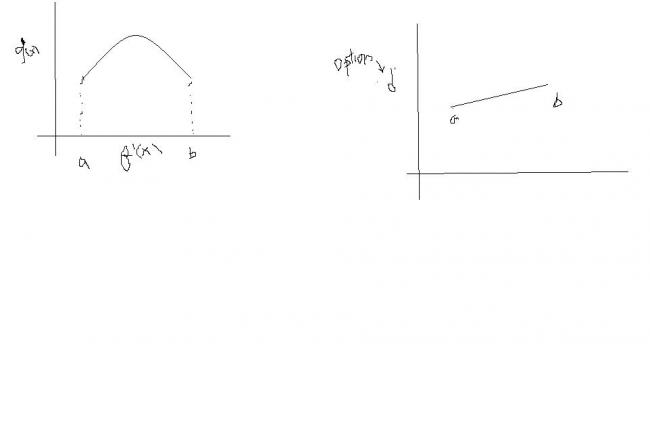"a"..., Other options still thinking [12]
vector A = f '(x) i + g '(x) j
vector B = i - f(x) j
then:
a) A and B are parallel atleast once in (a,b) if g(a) = g(b)
b) A and B are perpendicular atleast once in (a,b) if g(a) = g(b)
c) A and B are paralle at all x belonging to (a,b)
d) there exists atleast one function g(x) for which A and B are parallel for all x belonging to (a,b)
-
UP 0 DOWN 0 0 13

13 Answers
For (a)
Reason:
If they r parallel u can write as
λ(vector A ) +μ (vector B)=0
where λ + μ=0
On simplifying u get
(λ * f'(x) + μ ) i + (λ * g'(x) + μ * f(x) ) j =0
=> f'(x) = -μ/λ , g'(x)/ f(x) = μ/λ
Therefore f'(x) = - g'(x)/f(x)
=>f(x).f'(x) = -g(x)----------------------------------------------(1)
If g(a) = g(b) => g(x)=0 in the interval (a,b)......Rolle's Theorem
=> f(x) =0 or f'(x)=0
Sub (1) in vector A and B
U ll get
A = f'(x)[ i - f(x) j]
B = i - f(x) j
=> A abd B r collinear foratleast one value in (a,b)....
For (a) justification:
A x B = (f'(x) i + g('x) j) x ( i - f(x) j)
= -f'(x)f(x) k - g(x) k
From (1)
A x B = [g'(x) - g'(x)] k =0
(Only when "hidden part " is satisfied)
C is not the answer, coz u can say that only one value exists in (a,b) where g'(x) = 0..............Rolle's theorem
For d ...
I think it is constant function f(x) so thall values will make A n B parallel....
U can easily understand dis by graphs.... 
Sorry .. in second graph ab is a line parallel to x-axis....
For (b)
A.B==0
=> A.B=f'(x) -f(x).g'(x) = 0
f'(x) = f(x).g'(x)
If g(a) =g(b) den 4 atleast one value g'(x) =0
==> f'(x) = 0.....................................(2)
Sub (2) in A and g'(x) = 0 in B
we get A = g(x) j
B = i
Obviously both r perpendicular to each other..[1][4]
Am i rite????
[56] [69] [12] [34]